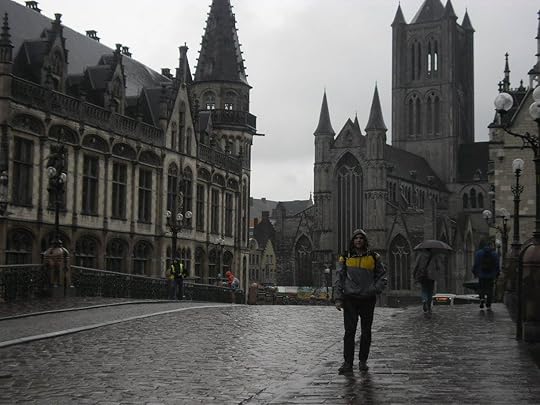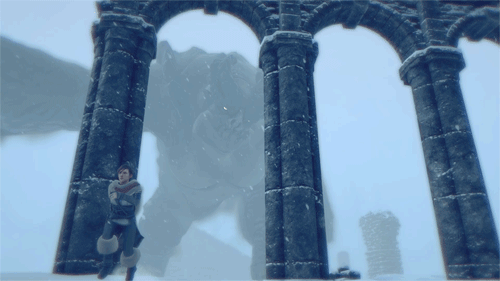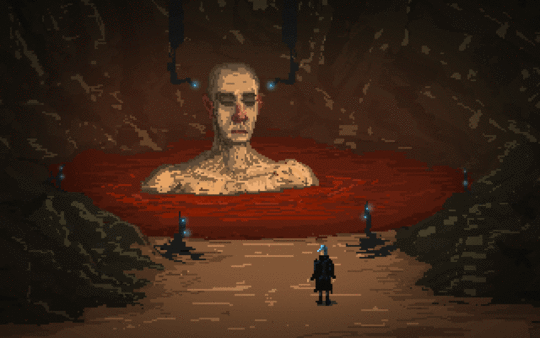Kill Screen Magazine's Blog, page 207
October 22, 2015
Next up, Tale of Tales is making a virtual reality cathedral
Tale of Tales has revealed what its "non-game art project" Cathedral-in-the-Clouds is all about by launching a Kickstarter to fund it. The idea is to create a cathedral that you can enter through a virtual reality headset and then, from there, admire a series of dioramas located within its radiating chapels.
The project is born from a passion found in both halves of the studio, Auriea Harvey and Michaël Samyn, for the "intense" religious art found especially around their current home in Ghent, Belgium, as well as nearby places such as Bruges too it would seem. Ghent itself is a city notable for its range of abbeys, churches, and the spectacular St. Bavo's Cathedral, all of which are fashioned with genuine Gothic and Renaissance art.
struggling to take in the huge scope and minuscule detail
I visited Ghent myself back in August and found became captivated by both the architecture on the outside and the rich artwork to be found inside. It's a city watched over by a gilded dragon atop the belfry and where a grand 12th century "castle of the counts" that was privy to torture and execution sits. Life-sized carvings of people wrapped in cloth also adorn the walls of some of the buildings. But it's not just these figures that make the place feel alive in its stone setting. The decorative aspects of the buildings such as the pointed arches, stepped rooftops, and notched walls give them character that we have lost to utilitarian building design.

When you're stood among it all, struggling to take in the huge scope and minuscule detail around you, it's easy to see why Tale of Tales would want to bring that experience to more people through virtual reality. I'd smuggle myself into their office as one of their cats if it meant I could return to the city. But I guess having a slice of it temporarily recreated in front of my eyes will have to do for now.
Plus, it'd be great to witness the architecture such as that found in Ghent without getting drenched. Compare the photo of Auriea and Michaël in Ghent at the top of this article and the one of myself in the same spot above (mind you, the gloominess did add to the imposing nature of those buildings).
"We should all have works of art in our pockets"
Zooming in a little more on what this virtual cathedral will contain, Tale of Tales has said that it will be an "ever expanding collection of virtual dioramas depicting scenes created for contemplation." Yes, there won't necessarily be any interaction or game elements here; you're tasked only with observing and thinking.
If you don't have access to a virtual reality headset then the dioramas will be available in alternative forms: downloads, webpages, apps, video, and so on. The intended experience is, of course, for them to be part of a larger exploration inside the titular cathedral. But, even above that, this project is about making the art usually found in museums and churches accessible and convenient. "We should all have works of art in our pockets or on our laptops, for when the mood strikes, or when we need a moment of calm and focus," reasons Tale of Tales.
As to the dioramas, they are said to be inspired by medieval art, consisting of a box that houses a life-sized virtually sculpted body—a saint, or the Virgin Mary, or Jesus Christ. They'll all relate to an ancient story that will handily be explained for those unfamiliar with it. This much you can get if you visit artworks yourself, but what you won't get is what Tale of Tales is offering: dioramas that seem alive. Their chests will move up and down as they breathe, insects will scurry, wind will push cloth around. Not only that, entire animated scenes will play out as you watch, giving you a little more than the still object to consider.
Tale of Tales plans to make Cathedral-in-the-Clouds available for free. But to ensure it can happen the studio is looking for €35,000 on Kickstarter. You can support the project to get access to early builds, essays collated as a digital book, as well as getting your name or image into the virtual cathedral itself.
Mattel revamps its Barbie marketing strategy to empower girls through play
Girls are important, play is important.
Free fall to your heart's content in Downwell
Sign up to receive each week's Playlist e-mail here!
Also check out our full, interactive Playlist section.
Downwell (PC, Mac)
BY Moppin
In most games, falling is essentially akin to certain death. Step an inch over the edge, and the void is there to swallow you up and take some of your health along with it. But in Downwell, falling is the exact opposite of an abyss. It is everything: life, death, and all else in between. In this vertical shoot-em-up, you must find the wherewithal to fight ghoulish monsters and gather resources while you free fall down a seemingly endless well (is the name making more sense now?). But your time in Downwell is more than just frantic. The darkness of the well is offset by the adorable character animations and an exceedingly confident execution that can charm even the most acrophobic players. Coupled with its nostalgic aesthetic and soundscape provided by Spelunky musician Eirik Suhrke, you'll find yourself falling for Downwell in more ways than one.
Perfect for: Tom petty fans, shoot-em-uppers, sky divers
Playtime: From twenty minutes to several hours

The #Victorian frame of mind: A review of Assassin���s Creed Syndicate
With Assassin’s Creed Syndicate, Ubisoft’s machinelike series finally finds its era.
Science says your gaming experiences may be shams
In case you weren’t already convinced that games are total bullshit, here’s a study in the New Scientist that claims the placebo effect—that noted scourge of hypochondriacs and homeopaths—also works in videogames.
Ok, not everything is bullshit, but at least some of it is. The study at hand, which was conducted by the University of York’s Paul Cairns, found that perceptions of games could be influenced by erroneous information about their specs. Cairns and his collaborators told participants that they were playing a two-level game: the first used a map selected at random and the second used a map that adapted to their skill level using artificial intelligence. This was not true: Both levels were randomly generated. But the New Scientist’s Aviva Hope Rutkin notes:
When players thought that they were playing with AI, they rated the game as more immersive and more entertaining. Some thought the game was harder with AI, others found it easier – but no one found it equally challenging.
Oh.
Does this mean that everything we know about gaming is a lie? Probably not. Powers of suggestion are, well, powerful but they’re not all-powerful. Your entire life is not a lie, unless it is wholly predicated on the existence of Santa Claus or the effectiveness of trickle-down economics. But little moments of joy that you associated with game mechanics may have been caused by something other than the game’s mechanics.
That isn’t the worst of outcomes. At a certain level, it doesn’t really matter where your happiness comes from so long as you are indeed happy. But if you can be convinced that a game is better just by being told that it has some fancy feature, there is a non-negligible risk of your being bilked on a regular basis. The features-for-features-sake debate is bad enough already, but this finding is only likely to make it worse. Still, some people were made happy by a game—a game sold on a lie, but a game nonetheless. Unlike homeopathy, that’s not bullshit.
Behind the humor of Toby Fox���s Undertale
The sly, Lynchian humor of this year’s subversive RPG hit.
October 21, 2015
Prey for the Gods brings back memories of Shadow of the Colossus
Few games have topped the truly epic scale of Shadow of the Colossus and its iconic boss battles, but an upcoming game called Prey for the Gods looks like a worthy comparison.
Created by No Matter, the recently revealed Prey for the Gods will have you battling huge deities on a frozen island in a journey to find the cause behind an eternal winter. Besides a few screenshots and a reveal trailer, that’s about all the information available for now, but what’s out there looks promising.
Prey for the Gods seems to understand what made Shadow of the Colossus such a heroic adventure to begin with. It wasn’t just that the bosses were big, but that you, the adventurer, were so, so small—not only in comparison to the mysterious beasts you fight, but to the world around you as well. Vast, open spaces, towering monuments, and looming cliffs all worked together to emphasize just how miniscule you were in the grand scheme of things, making your achievements feel larger than life.
According to the developers, Prey for the Gods even has the approval of Shadow of the Colossus level designer Takeshi Asano, who says the game seems “very good.”

Shadow of the Colossus isn’t the only game that inspires its creators Brian Parnell, Hung-Chien Liao, and Tim Wiese.
In an interview with 80.lv, the three also mention the importance of choice and consequence in Deus Ex, the emergent stories of DayZ and even FTL, and the combat of Bloodborne. How the game design decisions of these titles will influence Prey for the Gods, if at all, has yet to be seen, but Parnell does say that “mood, direction and story” are the major points of focus for their project.
Find out more about Prey for the Gods on its website.
Timebound is a new app that will have you living out history in real time
History, in case you were wondering, covers a good chunk of time. Much of that time has been horrible, but there’s plenty of it. How, then, does one go about representing history? Should the focus be on the time or the suffering?
The normal solution to this problem, as is evidenced by the history section of any bookstore, is to focus on suffering over time. The thousands of World War II books may feel like they take years to read, but they are each about 500 pages long. They are indexes of suffering. Timebound, which is being announced on “Back to the Future Day,” aims to reverse that trend and put the emphasis on time.
The game, which was developed by Mika Golubovsky and what he describes in an email to Kill Screen as “a team of writers, designers and developers with experience in media and academic history,” provides push notifications for historical events spaced out at verisimilar intervals. The events that will come with the initial release apparently range from a couple days to a couple years, though Golubovsky writes, “We’re even thinking about the Hundred Years’ War, so people have a chance to share the experience with their grandkids.”
This raises a few questions, which point to both the potential challenges inherent in this concept and its appeal.
trying to make history tangible
First, how long does a phone last? The average smartphone has a lifespan in the region of three years, which means that it’s not clear what you’d be handing down to your grandkids. Or, to use a more charitable example, the odds of your phone outlasting a real-time rendition of World War II are not favourable. This is an interesting reflection on physical and digital mortality, though it is probably not the point Timebound is trying to make. The app is, in a sense, trying to make history tangible, but for events longer than a few months, it is actually likely to produce another piece of digital ephemera—a login you carry from phone-to-phone, assuming you don’t forget it. You can carry history with you, but it’s easier to shake than the real thing.
The question, then, becomes how often your phone buzzes? Here’s how Golubovsky explains it:
Once you’ve picked an event, you get push-notifications about its every twist and turn. You live through the event, hour by hour. So if you picked World War Two, you’ll be living in it for six years, receiving all the significant information at the exact time of day it had actually happened.
So there’s your answer: possibly every hour. Which, I don’t know? Why not every few minutes? It’s hard to argue that significant events do not sometimes follow one another in rapid succession. And maybe Timebound really will go there. The sinking of the Titanic, which is one of the events set to be included in the beta version, could conceivably work in this timeframe.

One other question: What might Timebound do when nothing of note was happening? Borrowing Golubovsky’s Hundred Years War, what might be made of the relative peacetimes of 1360-69 and 1389-1415? Would your phone go silent for nine and 16 years, respectively? Would you wake up one morning, now lacking the follicular endowment of the last time Timebound served you a notification, and suddenly discover that hostilities had resumed under Henry V? This is both a fascinating prospect and a somewhat impractical idea: The ideal interval between notifications is probably not longer than it takes to conceive, gestate and raise a child up to their Bar Mitzvah. This, incidentally, is probably why Golubovsky notes that the Hundred Years War is an idea for down the line and not right now. The sinking of the Titanic has far more practical pacing—unless you're James Cameron, that is.
It’s not like World War II had a good user experience.
Might this all be a bit much? That is the ultimate luxury of exposing yourself to history ex post facto: You can set your own terms of engagement. So maybe a minute-by-minute wouldn’t be historiographically excessive, but it would probably constitute a poor user experience. (Note that this is not what Timebound proposes; it is simply the fullest extension of its premise.) Which, again, fair enough. It’s not like World War II had a good user experience. The great irony of Timebound is that a part of the project exists in the past but its questions about the curation and frequency of push notifications is very much of the present. Timebound purports to be a real-time rendition of history but there are subjective judgments—technological, historical, and otherwise—embedded in this recreation.

There’s nothing wrong with that. A certain amount of subjectivity is inherent on all historical undertakings. Most such undertakings, however, do not present themselves as real-time renderings. The compression of time makes the inherent judgments more apparent: obviously things had to be culled a bit to fit a book. Timebound, like the many niche historical Twitter accounts that tweet out events, are in comparatively uncharted territory. There are just as many judgment calls to be made here, but our understanding of what the form entails lags behind.
You can find out more about Timebound on its website.
Babycastles Living celebrates furniture with videogames and wacky exhibits
The internet's rapid consumption tears into furniture design.
The world of Death Trash is gross, but you won���t be able to look away
Desert punks in a puke bar. Gore on the cave walls. A giant weeping blood into a lava pit. It can only be… Death Trash!
Death Trash is an upcoming game pitched as a post-apocalyptic RPG mash-up of Planescape: Torment and Ultima 7, with added helpings of sex, cyberpunk, and horror. At first glance, I’m not personally interested in the role-playing elements—what captivates me most is how casually disgusting this world looks.
Sickness and violence seem to be at the heart of this abrasive new society, where sweet-talking, telekinetic punks with shotguns roam and raw, gory meat seems to burst from the earth like a disease. Why, I don’t know. But this will apparently be a normal exchange in your journey:

Skim through some of its screenshots for some similarly profane sights. A giant, red-fleshed blob of a person sprouting sinuous tentacles sits tied up in a cave, evoking images of Akira’s mutated Tetsuo. A mass of swollen, pus-dripping sludge snakes its way up a cave wall, bulging eyeballs of all sizes from its gory pink sinew. Pleasant.
According to its website, Death Trash will feature “rich dialogue,” real-time combat, a stats system, item crafting, and local co-op.
It’s headed to PC, Mac, and Linux sometime in “2016 or later.”

Learn more about Death Trash on its website.
Kill Screen Magazine's Blog
- Kill Screen Magazine's profile
- 4 followers



